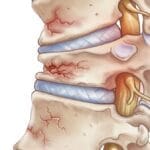Introduction
Neck pain and arm pain often occur together, a relationship that can be both complex and debilitating. Understanding the connection between these two types of pain is crucial for effective diagnosis and treatment. This article will explore the underlying causes, the symptoms, and the various treatment options available for those suffering from neck and arm pain. Additionally, we will address frequently asked questions to provide a comprehensive resource for those seeking relief.
Understanding the Anatomy
The neck, or cervical spine, consists of seven vertebrae that support the head and protect the spinal cord. Nerves branching out from the cervical spine innervate the shoulders, arms, and hands, making the neck a crucial hub for the transmission of signals between the brain and upper limbs. When an issue arises in the cervical spine, it can affect these nerves, leading to pain that radiates from the neck down to the arm.
Common Causes of Neck and Arm Pain
- Cervical Radiculopathy
This condition occurs when a nerve root in the cervical spine becomes compressed or irritated, often due to a herniated disc or bone spurs. Symptoms include sharp, shooting pain, numbness, and tingling that extends from the neck into the arm. Weakness in the arm muscles may also occur, making it difficult to perform everyday tasks. - Muscle Strain
Poor posture, repetitive motions, or sudden movements can strain the muscles in the neck, leading to pain that may radiate into the arm. This is often referred to as “referred pain” because the pain originates in the neck but is felt in the arm. - Cervical Spondylosis
Also known as arthritis of the neck, this condition involves the degeneration of the bones and cartilage in the cervical spine. It can lead to spinal stenosis, a narrowing of the spinal canal, which compresses the nerves and causes pain in the neck and arm. - Whiplash
Whiplash is a neck injury caused by a sudden movement of the head, typically from a car accident. This can strain the neck muscles and ligaments, leading to pain that radiates down the arm. - Thoracic Outlet Syndrome
This condition occurs when the nerves or blood vessels in the space between the collarbone and first rib (thoracic outlet) are compressed. Symptoms include pain, numbness, and weakness in the neck, shoulder, and arm.
Symptoms to Watch For
- Localized Neck Pain: Often the first symptom, this pain can be dull or sharp and may radiate down the arm.
- Arm Pain: This can range from a dull ache to a sharp, shooting pain, and may be accompanied by numbness or tingling.
- Weakness: Muscle weakness in the arm, making it difficult to grip objects or perform tasks.
- Limited Range of Motion: Difficulty in moving the neck or arm, especially when turning the head or lifting the arm.
- Numbness and Tingling: Commonly felt in the fingers, hand, or forearm, indicating nerve involvement.
Diagnostic Approaches
Diagnosing the exact cause of neck and arm pain requires a thorough medical evaluation. Doctors may use the following methods:
- Physical Examination: Assessing the range of motion, reflexes, and strength in the neck and arm.
- Imaging Tests: MRI, CT scans, and X-rays can help visualize the cervical spine and identify issues like herniated discs or spinal stenosis.
- Electromyography (EMG): This test measures the electrical activity of muscles and nerves, helping to identify nerve compression.
Treatment Options
- Physical Therapy
Physical therapy is often the first line of treatment, focusing on exercises and stretches to improve strength, flexibility, and posture. Manual therapy techniques may also be used to relieve pressure on the nerves. - Medications
Over-the-counter pain relievers, anti-inflammatory drugs, and muscle relaxants can help manage symptoms. In some cases, corticosteroid injections may be used to reduce inflammation. - Lifestyle Modifications
Adopting ergonomic practices, maintaining good posture, and avoiding activities that strain the neck can help manage and prevent pain. - Surgery
In severe cases, when conservative treatments fail, surgery may be necessary to relieve nerve compression. Procedures like discectomy, laminectomy, or spinal fusion may be considered. - Alternative Therapies
Acupuncture, chiropractic care, and massage therapy may provide relief for some individuals. These therapies can complement traditional treatments and help manage pain.
Prevention Tips
- Maintain Good Posture: Keeping your head aligned with your spine can reduce strain on the neck.
- Strengthening Exercises: Regularly performing neck and shoulder exercises can help maintain flexibility and strength.
- Ergonomic Adjustments: Ensure your workspace is set up to minimize strain on your neck and shoulders.
- Avoid Repetitive Motions: Take breaks and stretch regularly to prevent overuse injuries.
Frequently Asked Questions
- Can neck pain cause arm numbness?
Yes, neck pain can lead to arm numbness if a nerve in the cervical spine is compressed or irritated. This condition is known as cervical radiculopathy. - What is the best sleeping position to avoid neck and arm pain?
Sleeping on your back with a supportive pillow that keeps your neck aligned with your spine is generally recommended. Avoid sleeping on your stomach, as it can strain the neck. - How long does it take for neck and arm pain to heal?
The healing time varies depending on the cause and severity of the condition. Mild cases may improve within a few weeks, while more severe cases may require several months of treatment. - Should I see a doctor if my neck pain radiates to my arm?
Yes, it is important to seek medical attention if you experience neck pain that radiates to your arm, especially if it is accompanied by numbness, tingling, or weakness. - Can stress cause neck and arm pain?
Yes, stress can contribute to muscle tension in the neck and shoulders, potentially leading to pain that radiates into the arm.
Conclusion
Understanding the connection between neck and arm pain is crucial for effective treatment and management. By identifying the underlying causes and following appropriate treatment strategies, individuals can find relief from these often debilitating symptoms. If you experience persistent or severe neck and arm pain, it is important to consult a healthcare professional for an accurate diagnosis and personalized treatment plan.





